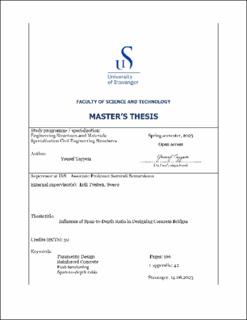| dc.description.abstract | The influence of the span-to-depth ratio in designing concrete bridges is a critical aspect of bridge engineering. This study focuses on investigating the span-to-depth ratios of reinforced concrete bridges and post-tensioned concrete bridges. The main objective of the research is to establish a new basis for determining the height of the bridge deck based on selected span lengths for three-span simply supported reinforced and post-tensioned plate bridges.
Nine bridge models with varying mid-span lengths ranging from 8 to 40m are analyzed to examine the relationship between the mid-span length and plate thickness. These models cover a range of mid-span to plate thickness ratios from 17.77 to 34.28. The side spans is set to 0.3 times the total bridge length (L), and the mid-span is set to 0.4 times the total bridge length (L). The transition point from reinforced to post-tensioned concrete is identified, and the optimal span-to-depth ratio for reinforced concrete bridges is determined. The bridge models are analyzed using the Sofistik software and its Teddy programming language (CADINP), considering design requirements for ultimate limit state (ULS) and serviceability limit state (SLS).
The research adopts a parameterized approach, utilizing code in Sofistik to automatically generate bridge models based on input parameters, such as bridge length and depth. This parameterization allows for efficient and automated generation of loads and actions, dynamically adjusted whenever new structural parameters are inputted. As a result, comprehensive analysis of various load and action scenarios can be performed, specifically tailored to the specific bridge length. This approach enables a thorough exploration of the bridge's behavior under different loading conditions, leading to a more informed and optimized design.
The analysis reveals that the ULS governs the design for bridge models 8, 12, and 16, while the SLS governs the design for bridge model 20. For post-tensioned bridge models, the SLS governs the design for all of them. The findings demonstrate that the required cross-section height of a bridge varies with the span length. Specifically, the transition from reinforced to post-tensioned concrete occurs at a bridge length of 60m or when the middle span length is 24m. Additionally, the deflection control meets the requirements specified by EC2 and N400, ensuring the structural functionality of the bridges. | |
